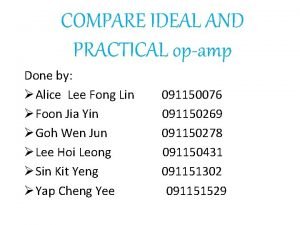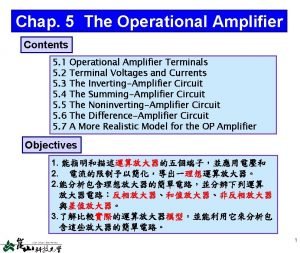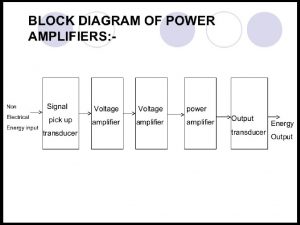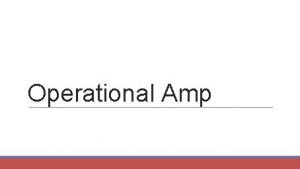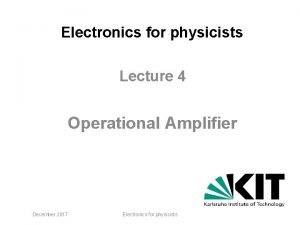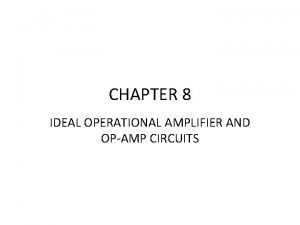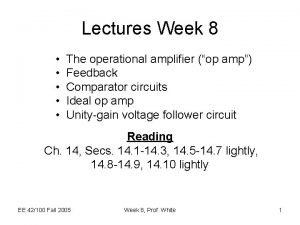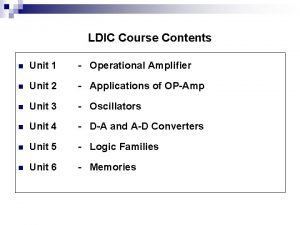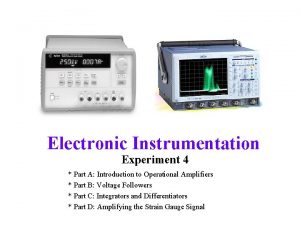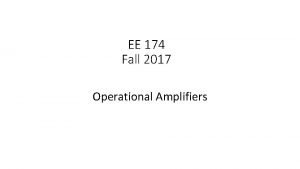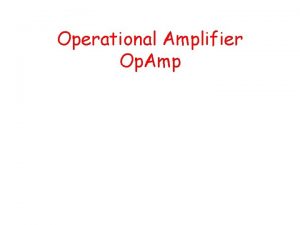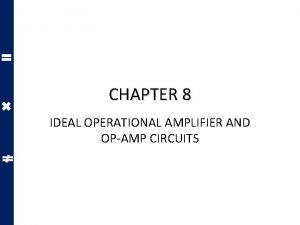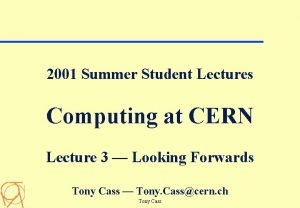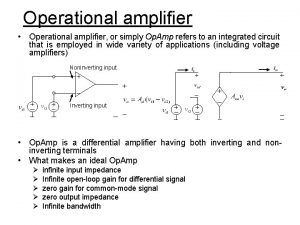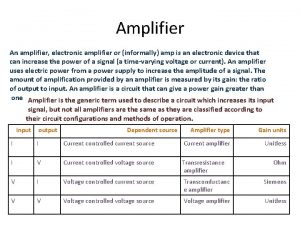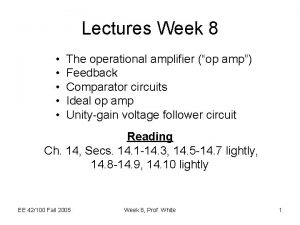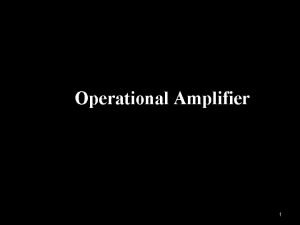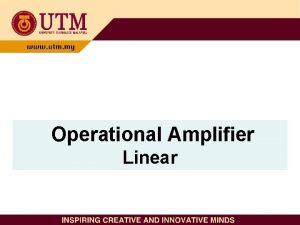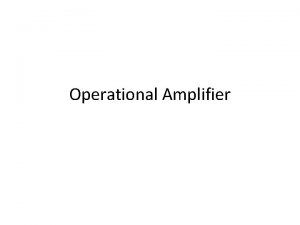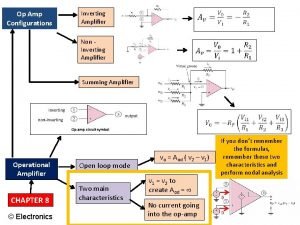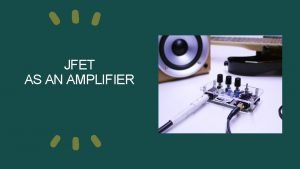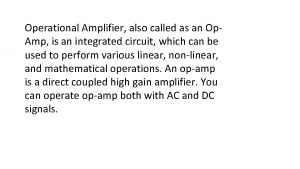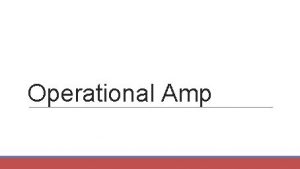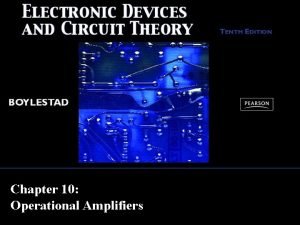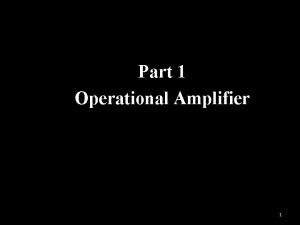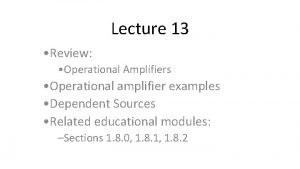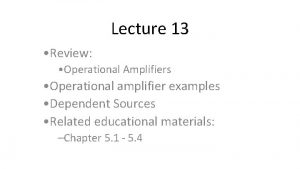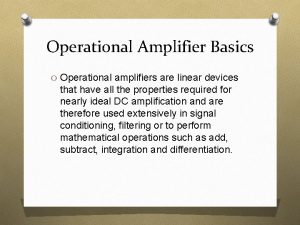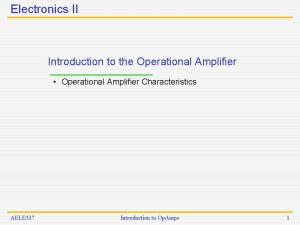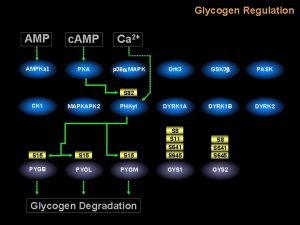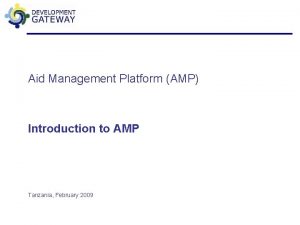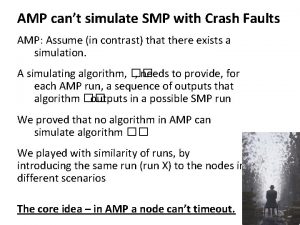Lectures Week 8 The operational amplifier op amp



































- Slides: 35

Lectures Week 8 • • • The operational amplifier (“op amp”) Feedback Comparator circuits Ideal op amp Unity-gain voltage follower circuit Reading Ch. 14, Secs. 14. 1 -14. 3, 14. 5 -14. 7 lightly, 14. 8 -14. 9, 14. 10 lightly EE 42/100 Fall 2005 Week 8, Prof. White 1

The Operational Amplifier • The operational amplifier (“op amp”) is a basic building block used in analog circuits. – Its behavior is modeled using a dependent source. – When combined with resistors, capacitors, and inductors, it can perform various useful functions: • amplification/scaling of an input signal • sign changing (inversion) of an input signal • addition of multiple input signals • subtraction of one input signal from another • integration (over time) of an input signal • differentiation (with respect to time) of an input signal • analog filtering • nonlinear functions like exponential, log, sqrt, etc. EE 42/100 Fall 2005 Week 8, Prof. White 2

Op Amp Circuit Symbol and Terminals V+ non-inverting input + positive power supply output – V – negative power supply The output voltage can range from V – to V + (“rails”) The positive and negative power supply voltages do not have to be equal in magnitude (example: 0 V and +3 V DC supplies) EE 42/100 Fall 2005 Week 8, Prof. White 3

Op Amp Terminal Voltages and Currents • All voltages are referenced to a common node. • Current reference directions are into the op amp. V+ ic+ ip + vp in + vn + – io + ic. V– – vo + – Vcc – – + common node EE 42/100 Fall 2005 (external to the op amp) Week 8, Prof. White 4

Op-Amp Voltage Transfer Characteristic The op-amp is basically a differentiating amplifier: vo Vcc slope = A >>1 vid = vp–vn -Vcc Regions of operation: “negative saturation” “linear” “positive saturation” In the linear region, vo = A (vp – vn) = A vid where A is the open-loop gain Typically, Vcc 20 V and A > 104 à linear range: -2 m. V vid = (vp – vn) 2 m. V Thus, for an op-amp to operate in the linear region, vp vn (i. e. , there is a “virtual short” between the input terminals. ) EE 42/100 Fall 2005 Week 8, Prof. White 5

Achieving a “Virtual Short” Recall the voltage transfer characteristic of an op-amp: Plotted using different scales for vo and vp–vn Plotted using similar scales for vo and vp–vn vo vo Vcc slope = A >>1 ~10 V vp–vn Vcc slope = A >>1 ~10 V -Vcc vp–vn -Vcc ~1 m. V ~10 V Q: How does a circuit maintain a virtual short at the input of an op-amp, to ensure operation in the linear region? A: By using negative feedback. A signal is fed back from the output to the inverting input terminal, effecting a stable circuit connection. Operation in the linear region enforces the virtual short circuit. EE 42/100 Fall 2005 Week 8, Prof. White 6

Negative vs. Positive Feedback Familiar examples of negative feedback: • Thermostat controlling room temperature • Driver controlling direction of automobile • Pupil diameter adjustment to light intensity Familiar examples of positive feedback: • Microphone “squawk” in sound system • Mechanical bi-stability in light switches EE 42/100 Fall 2005 Week 8, Prof. White Fundamentally pushes toward stability Fundamentally pushes toward instability or bi-stability 7

Op Amp Operation without Negative Feedback (Comparator Circuits for Analog-to-Digital Signal Conversion) 1. Simple comparator with 1 Volt threshold: V– is set to 0 Volts (logic “ 0”) V+ is set to 2 Volts (logic “ 1”) A = 100 VIN + V 0 2 1 If VIN > 1. 01 V, V 0 = 2 V = Logic “ 1” 0 1 1 V + If VIN < 0. 99 V, V 0 = 0 V = Logic “ 0” 2. Simple inverter with 1 Volt threshold: V– is set to 0 Volts (logic “ 0”) V+ is set to 2 Volts (logic “ 1”) A = 100 1 V + VIN EE 42/100 Fall 2005 VIN 2 + V 0 2 1 Week 8, Prof. White 0 1 If VIN < 0. 99 V, V 0 = 2 V = Logic “ 1” 2 VIN If VIN > 1. 01 V, V 0 = 0 V = Logic “ 0” 8

Op Amp Circuits with Negative Feedback Q: How do we know whether an op-amp is operating in the linear region? A: We don’t, a priori. • Assume that the op-amp is operating in the linear region and solve for vo in the op-amp circuit. – If the calculated value of vo is within the range from -Vcc to +Vcc, then the assumption of linear operation might be valid. We also need stability – usually assumed for negative feedback. – If the calculated value of vo is greater than Vcc, then the assumption of linear operation was invalid, and the op-amp output voltage is saturated at Vcc. – If the calculated value of vo is less than -Vcc, then the assumption of linear operation was invalid, and the op-amp output voltage is saturated at -Vcc. EE 42/100 Fall 2005 Week 8, Prof. White 9

Op Amp Circuit Model (Linear Region) vp Ri is the equivalent resistance “seen” at the input terminals, typically very large (>1 MW, as large as 1012 W for FET input opamps), so that the input current is usually very small: ip = –in 0 ip Ro Ri io vo + A(v –v ) p n – vn in EE 42/100 Fall 2005 Note that significant output current (io) can flow when ip and in are negligible! Week 8, Prof. White 10

Ideal Op-Amp • • Assumptions: – Ri is large ( 105 W) – A is large ( 104) – Ro is small (<100 W) ip = –in= 0 vp = vn Simplified circuit symbol: – power-supply terminals and dc power supplies not shown Note: The resistances used in an op-amp circuit must be much larger than Ro and much smaller than Ri in order for the ideal op-amp equations to be accurate. EE 42/100 Fall 2005 ip + + in + vp – Week 8, Prof. White vn – – io + vo – 11

Unity-Gain Voltage-Follower Circuit VIN vp + IIN vn V 0(V) V 0 vp = vn V 0 = VIN 2 1 1 2 VIN(V) ( valid as long as V – V 0 V + ) Note that the analysis of this simple (but important) circuit required only one of the ideal op-amp rules. Q: Why is this circuit important (i. e. , what is it good for)? A: A “weak” source can drive a “heavy” load; in other words, the source VIN only needs to supply a little power (since IIN = 0), whereas the output can drive a power-hungry load (with the op-amp providing the power). EE 42/100 Fall 2005 Week 8, Prof. White 12

What’s Inside an Op-Amp? EE 42/100 Fall 2005 Week 8, Prof. White 13

Lecture Week 8 (continued) • Op-Amp circuits continued: examples: • • • Inverting amplifier circuit Summing amplifier circuit Non-inverting amplifier circuit Differential amplifier circuit Current-to-voltage converter circuit Reading (Note: amplifiers are discussed in great detail in Ch. 11) EE 42/100 Fall 2005 Week 8, Prof. White 14

Review: Negative Feedback Negative feedback is used to “linearize” a high-gain differential amplifier. With feedback V V+ V 0 + Without feedback VIN + V 0(V) V 0 5 5 4 3 2 1 1 2345 VIN 5 EE 42/100 Fall 2005 Week 8, Prof. White 15

Gain vs. Frequency of the Basic Op-Amp without and with Feedback (Hambley, Sec. 14. 5) Facts: 1. The open-loop gain of an op--amp (no feedback from output to inverting input) is constant from DC to a frequency f. BOL, after which the open-loop gain drops at a rate of -20 d. B/decade of frequency (Fig. 14. 20 – next slide). 2. As the negative feedback is made stronger, the gain decreases but the bandwidth of the amplifier increases. (Bandwidth of an amplifier is the frequency range over which it amplifies. ) 3. One can show (Hambley) that the product of the dc gain and the bandwidth is a constant that is independent of the amount of negative feedback. This is called the gain-bandwidth product for the op-amp. Example: The op-amp you’ll use in the lab (National Semiconductor LMC 6482) is rather like that shown in Hambley Fig. 14. 22, with a DC open-loop gain of 100 d. B (voltage amplification of 105) out to about only 40 Hz! With negative feedback, however, the amplifier has an increasing bandwidth but with decreasing gain. The unity gain (0 d. B) bandwidth is 4 MHz; one can get 40 d. B of gain (Vout/Vin = 100) from DC to about 40 k. Hz. EE 42/100 Fall 2005 Week 8, Prof. White 16

Op-Amp Frequency Response with and without Negative Feedback EE 42/100 Fall 2005 Week 8, Prof. White 17

Application of Voltage Follower: Sample and Hold Circuit EE 42/100 Fall 2005 Week 8, Prof. White 18

Inverting Amplifier Circuit in + – + vs vn + vp – – + Rs if – is Rf + vo – in = 0 is = -if vp = 0 vn = 0 EE 42/100 Fall 2005 Week 8, Prof. White 19

Analysis using Realistic Op-Amp Model • In the analysis on the previous slide, the op-amp was assumed to be ideal, i. e. Ri = ; A = ; Ro = 0 • In reality, an op-amp has finite Ri, finite A, non-zero Ro, and usually is loaded at its output terminals with a load resistance RL. EE 42/100 Fall 2005 Week 8, Prof. White 20

Summing Amplifier Circuit Ra ib + – + ic vc – + vb in Rc vn + vp – – + va Rb Rf if – ia + vo – superposition ! in = 0 ia + ib + ic = -if vp = 0 vn = 0 EE 42/100 Fall 2005 Week 8, Prof. White 21

Application: Digital-to-Analog Conversion A DAC can be used to convert the digital representation Binary Analog number output of an audio signal into an analog voltage that is then (volts) used to drive speakers -- so that you can hear it! 0000 0 “Weighted-adder D/A converter” S 4 20 K 40 K S 2 80 K +- S 1 4 -Bit D/A (Transistors are used as electronic switches) EE 42/100 Fall 2005 5 K + + S 3 8 V 10 K V 0 S 1 closed if LSB =1 S 2 " if next bit = 1 S 3 " if " " = 1 S 4 " if MSB = 1 Week 8, Prof. White 0001 0010 0011 0100 0101 0110 0111 1000 1001 1010 1011 1100 1101 1110 1111 MSB . 5 1 1. 5 2 2. 5 3 3. 5 4 4. 5 5 5. 5 6 6. 5 7 7. 5 LSB 22

Analog Output (V) Characteristic of 4 -Bit DAC 8 7 6 5 4 3 2 1 0 0000 0 2 0001 EE 42/100 Fall 2005 4 0100 6 8 10 1000 Digital Input Week 8, Prof. White 12 14 16 1111 23

Noninverting Amplifier Circuit + vn vg Rg + – ip + in – Rs Rf vp + vo – – i p = 0 vp = vg vn = vg in = 0 Rs & Rf form a voltage divider EE 42/100 Fall 2005 Week 8, Prof. White 24

Differential Amplifier Circuit Ra in – + vb ip vn Rd – + + – + Rc – + va Rb vp + vo – – in = 0 ip = 0 EE 42/100 Fall 2005 Week 8, Prof. White 25

Differential Amplifier (cont’d) More usual version of differential amplifier (Horowitz & Hill, “Art of Electronics”, 2 nd Ed. , p. 184 -5 (part of their “smorgasbord” of op-amp circuits): Let Ra = Rc = R 1 and Rb = Rd = R 2 Then v 0 = (R 2 / R 1)(vb – va) To get good “common-mode rejection” (next slide) you need well-matched resistors (Ra and Rc, Rb and Rd), such as 100 k. W 0. 01% resistors EE 42/100 Fall 2005 Week 8, Prof. White 26

Differential Amplifier – Another Perspective Redefine the inputs in terms of two other voltages: 1. differential mode input vdm vb – va 2. common mode input vcm (va + vb)/2 so that va = vcm – (vdm/2) and vb = vcm + (vdm/2) Then it can be shown that “common mode gain” EE 42/100 Fall 2005 “differential mode gain” Week 8, Prof. White 27

Differential Amplifier (cont’d) • An ideal differential amplifier amplifies only the differential mode portion of the input voltage, and eliminates the common mode portion. – provides immunity to noise (common to both inputs) • If the resistors are not perfectly matched, the common mode rejection ratio (CMRR) is finite: EE 42/100 Fall 2005 Week 8, Prof. White 28

Op-Amp Current-to-Voltage Converter EE 42/100 Fall 2005 Week 8, Prof. White 29

• Summary Voltage transfer characteristic of op-amp: vo Vcc slope = A >>1 ~10 V vp–vn -Vcc ~1 m. V • A feedback path between an op-amp’s output and its inverting input can force the op-amp to operate in its linear region, where vo = A (vp – vn) • An ideal op amp has infinite input resistance Ri, infinite open-loop gain A, and zero output resistance Ro. As a result, the input voltages and currents are constrained: vp = vn and ip = -in = 0 EE 42/100 Fall 2005 Week 8, Prof. White 30

EE 42/100 Fall 2005 Week 8, Prof. White 31

EE 42/100 Fall 2005 Week 8, Prof. White 32

EE 42/100 Fall 2005 Week 8, Prof. White 33

Differentiator (from Horowitz & Hill) EE 42/100 Fall 2005 Week 8, Prof. White 34

Op-Amp Imperfections Discussed in Hambley, pp. 651 -665 (of interest if you need to use an op-amp in a practical application!) Linear range of operation: Input and output impedances not ideal values; gain and bandwidth limitations (including gain-bandwidth product); Nonlinear limitations: Output voltage swing (limited by “rails” and more); output current limits; slew-rate limited (how fast can the output voltage change: 0. 5 V/ms for the 741 op-amp, to 6000 V/ms for high slew-rate op-amp); full-power bandwidth DC imperfections: Offset current (input currents don’t sum exactly to zero); offset voltage; There are pins (denoted offsets) for inputs to help control this. EE 42/100 Fall 2005 Week 8, Prof. White 35
 Comparison between ideal and practical op amp
Comparison between ideal and practical op amp Inverting amplifier
Inverting amplifier Difference between power and voltage amplifier
Difference between power and voltage amplifier Operational amplifiers
Operational amplifiers Simbol op amp
Simbol op amp Operational amplifier
Operational amplifier Closed loop gain of op amp
Closed loop gain of op amp What's inside an op amp
What's inside an op amp Op amp open loop configuration
Op amp open loop configuration Multistage amplifier conclusion
Multistage amplifier conclusion Operational amplifier experiment
Operational amplifier experiment Operational amplifier history
Operational amplifier history Input impedance of op amp
Input impedance of op amp Operational amplifier inverter
Operational amplifier inverter Week by week plans for documenting children's development
Week by week plans for documenting children's development Trend lectures
Trend lectures C programming lectures
C programming lectures Digital logic design lectures
Digital logic design lectures Utilities and energy lecture
Utilities and energy lecture Introduction to recursion
Introduction to recursion Pathology lectures for medical students
Pathology lectures for medical students Comsats virtual campus lectures
Comsats virtual campus lectures Advanced medicinal chemistry
Advanced medicinal chemistry Reinforcement learning lectures
Reinforcement learning lectures Cs106b lectures
Cs106b lectures Heel effect
Heel effect Power system lectures
Power system lectures Molecular biology lecture
Molecular biology lecture Cern summer school lectures
Cern summer school lectures Rcog cpd portfolio
Rcog cpd portfolio Rick trebino lectures
Rick trebino lectures Theory of translation lectures
Theory of translation lectures Jim kurose gaia
Jim kurose gaia Web engineering lectures ppt
Web engineering lectures ppt Guyton physiology lectures
Guyton physiology lectures Dr asim lectures
Dr asim lectures
